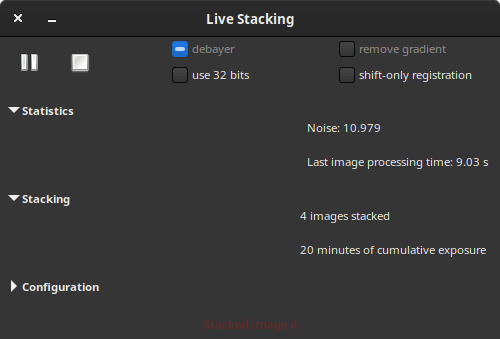Livestacking
Live Stacking is a technique in astrophotography that allows the real-time stacking of a series of images to produce a higher quality image. Unlike traditional image stacking, which involves combining multiple images after they have been captured, live stacking combines the images as they are being captured. This can provide an instant preview of the final image and allow the astrophotographer to make adjustments in real-time to improve the quality of the final result.
Siril 1.2.0 includes this feature, which however is experimental for the moment. It allows to monitor a file in real time and to stack the images that arrive as they come in. Stacking of images can be done with and without Dark/Bias/Flats. The latter must be done beforehand if you want to use them.
Livestacking (GUI)
Note
Only FITS and RAW camera images are compatible with livestacking.
To start livestacking you need to :
Define a working directory, with the home button, in which the photos will arrive one after the other.
Click on the framed button on the image below.

A new window pops up.

This window contains several buttons and options. A play button, which when clicked becomes a pause button, and a stop button. The first one allows to start or pause the monitoring of the working directory, and the last one to stop it.
All other options are fairly standard in the preprocessing of astronomical images:
debayer: The Bayer matrix is detected in files and debayer is automatically enabled. This is more of an indicator than an option.
use 32 bits: Use 32 bits for image processing. This is slower and generally useless in terms of quality for live stacking.
remove gradient: Apply a linear background gradient removal on calibrated input frames.
shift-only registration: Only shift images instead of using rotation on registration. This should be unchecked for alt-az or heavily drifting mounts. This makes one image processing much faster.
The 3 sections below provide the information necessary for the user to follow the evolution of the stack.
Statistics: This session gives the evolution of the noise level in ADU as well as the image processing time.
Stacking: This section summarizes the number of images stacked and the cumulative exposure time.
Configuration is a section that is not expanded by default. Once it is done, the frame gives details if the preprocessing is done using master files and the type of alignment and stacking.

Note
To use master files during a livestacking session, you must first have stacked your files. Then, once done and before launching the session, please load them in the Calibration tab. They will then be taken into account in the livestacking, and visible in the Configuration part of the livestack dialog.
Livestacking (Headless)
It is possible to use livestacking from the command line. For this, only 3 commands are necessary and explained below.
The first, start_ls starts the livestacking session. It is possible to provide it with darks and flats images as arguments in order to calibrate the images during livestacking.
Siril command line
start_ls [-dark=filename] [-flat=filename] [-rotate] [-32bits]
Initializes a livestacking session, using the optional calibration files and waits for input files to be provided by the LIVESTACK command until STOP_LS is called. Default processing will use shift-only registration and 16-bit processing because it's faster, it can be changed to rotation with -rotate and -32bitsNote that the live stacking commands put Siril in a state in which it's not able to process other commands. After START_LS, only LIVESTACK, STOP_LS and EXIT can be called until STOP_LS is called to return Siril in its normal, non-live-stacking, stateThe livestack command is to be applied to each image you wish to stack.
Siril command line
livestack filename
Process the provided image for live stacking. Only possible after START_LS. The process involves calibrating the incoming file if configured in START_LS, demosaicing if it's an OSC image, registering and stacking. The temporary result will be in the file live_stack_00001.fit until a new option to change it is addedLinks: start_lsFinally, the stop_ls command stops the livestacking session.
Siril command line
stop_ls